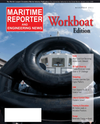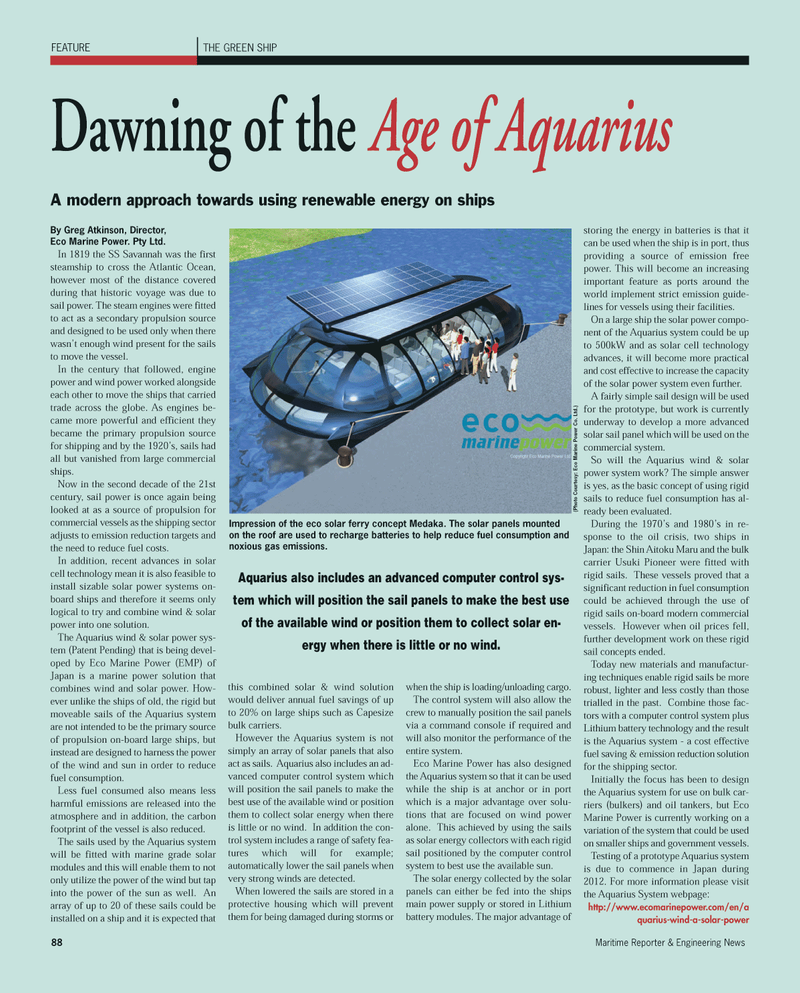
Page 88: of Maritime Reporter Magazine (November 2011)
Feature: Workboat Annual
Read this page in Pdf, Flash or Html5 edition of November 2011 Maritime Reporter Magazine
By Greg Atkinson, Director, Eco Marine Power. Pty Ltd. In 1819 the SS Savannah was the first steamship to cross the Atlantic Ocean, however most of the distance covered during that historic voyage was due to sail power. The steam engines were fitted to act as a secondary propulsion sourceand designed to be used only when therewasn?t enough wind present for the sails to move the vessel. In the century that followed, engine power and wind power worked alongside each other to move the ships that carried trade across the globe. As engines be- came more powerful and efficient they became the primary propulsion sourcefor shipping and by the 1920?s, sails had all but vanished from large commercial ships.Now in the second decade of the 21st century, sail power is once again being looked at as a source of propulsion for commercial vessels as the shipping sector adjusts to emission reduction targets and the need to reduce fuel costs.In addition, recent advances in solar cell technology mean it is also feasible toinstall sizable solar power systems on- board ships and therefore it seems onlylogical to try and combine wind & solarpower into one solution. The Aquarius wind & solar power sys- tem (Patent Pending) that is being devel- oped by Eco Marine Power (EMP) of Japan is a marine power solution that combines wind and solar power. How- ever unlike the ships of old, the rigid but moveable sails of the Aquarius system are not intended to be the primary sourceof propulsion on-board large ships, but instead are designed to harness the power of the wind and sun in order to reducefuel consumption. Less fuel consumed also means lessharmful emissions are released into theatmosphere and in addition, the carbonfootprint of the vessel is also reduced. The sails used by the Aquarius system will be fitted with marine grade solar modules and this will enable them to notonly utilize the power of the wind but tap into the power of the sun as well. An array of up to 20 of these sails could beinstalled on a ship and it is expected that this combined solar & wind solutionwould deliver annual fuel savings of up to 20% on large ships such as Capesize bulk carriers. However the Aquarius system is not simply an array of solar panels that alsoact as sails. Aquarius also includes an ad- vanced computer control system which will position the sail panels to make the best use of the available wind or position them to collect solar energy when there is little or no wind. In addition the con-trol system includes a range of safety fea-tures which will for example; automatically lower the sail panels when very strong winds are detected. When lowered the sails are stored in a protective housing which will prevent them for being damaged during storms orwhen the ship is loading/unloading cargo. The control system will also allow the crew to manually position the sail panels via a command console if required andwill also monitor the performance of theentire system.Eco Marine Power has also designed the Aquarius system so that it can be used while the ship is at anchor or in portwhich is a major advantage over solu- tions that are focused on wind power alone. This achieved by using the sails as solar energy collectors with each rigid sail positioned by the computer controlsystem to best use the available sun. The solar energy collected by the solar panels can either be fed into the shipsmain power supply or stored in Lithium battery modules. The major advantage of storing the energy in batteries is that it can be used when the ship is in port, thusproviding a source of emission free power. This will become an increasing important feature as ports around theworld implement strict emission guide- lines for vessels using their facilities. On a large ship the solar power compo- nent of the Aquarius system could be up to 500kW and as solar cell technologyadvances, it will become more practical and cost effective to increase the capacity of the solar power system even further. A fairly simple sail design will be used for the prototype, but work is currently underway to develop a more advanced solar sail panel which will be used on thecommercial system.So will the Aquarius wind & solar power system work? The simple answer is yes, as the basic concept of using rigidsails to reduce fuel consumption has al-ready been evaluated. During the 1970?s and 1980?s in re- sponse to the oil crisis, two ships in Japan: the Shin Aitoku Maru and the bulk carrier Usuki Pioneer were fitted with rigid sails. These vessels proved that a significant reduction in fuel consumption could be achieved through the use of rigid sails on-board modern commercialvessels. However when oil prices fell, further development work on these rigid sail concepts ended.Today new materials and manufactur- ing techniques enable rigid sails be morerobust, lighter and less costly than those trialled in the past. Combine those fac- tors with a computer control system plusLithium battery technology and the resultis the Aquarius system - a cost effective fuel saving & emission reduction solution for the shipping sector. Initially the focus has been to designthe Aquarius system for use on bulk car- riers (bulkers) and oil tankers, but Eco Marine Power is currently working on a variation of the system that could be used on smaller ships and government vessels. Testing of a prototype Aquarius system is due to commence in Japan during2012. For more information please visit the Aquarius System webpage: http://www.ecomarinepower.com/en/a quarius-wind-a-solar-power 88Maritime Reporter & Engineering NewsFEATURE THE GREEN SHIPDawning of the Age of Aquarius A modern approach towards using renewable energy on ships Impression of the eco solar ferry concept Medaka. The solar panels mounted on the roof are used to recharge batteries to help reduce fuel consumption and noxious gas emissions.(Photo Courtesy: Eco Marine Power Co. Ltd.) Aquarius also includes an advanced computer control sys- tem which will position the sail panels to make the best useof the available wind or position them to collect solar en-ergy when there is little or no wind. MR Nov.11 # 11 (80-88):MR Template 11/4/2011 11:22 AM Page 88

 87
87

 89
89
